The first Kepler’s law:
The orbit of every planet is an ellipse with the sun at one of the foci.
The Author (Leonid Popusoi):
The orbit of every planet is an ellipse with the centre of balance between Sun and planets at one of the foci.
By studying the history of scientific discoveries we can make sure that that the theories, which are based on experiments, are the stronger ones. "Only the experience gives you the right answer” - said Pasteur. Otherwise the theory would remain just a hypothetical idea.
It is made a discovery, on which base is forming a new conception in astronomy that gives an explanation why the Sun is not being the centre of the Universe.
Until the 16th century, the geocentric theory had been the dominant in astronomy, according to which, in the centre of the Universe is situated the motionless Earth and the Sun and stars revolve around it. A simple catholic canon, Nicolaus Copernicus has propounded a theory on that the centre, around which the Earth and stars revolve, is Sun. Thus, he had given a pulse to one of the greatest revolutions in people’s world view. First, the idea of Earth’s motion in those times had been considered a horrible error, because the Bible Sais that the Sun is moving. Second, according to biblical postulates, the human being is the greatest creation ever, and the Earth is the centre of Universe, thus, confirming that the Earth is an ordinary planet amongst other planets is an absurdity and blasphemy.
The idea about Earth’s motion wasn’t new itself, in antiquity this kind of world view was being studied by the supporters of pythagoreanism. This idea weren’t agreed by Aristotle. The teaching of Aristotle was being supported by church. In the struggle with this unquestionable authorities had been developing the heliocentric theory. The defensemen of it were N. Copernicus, Giordano Bruno, Galileo Galilee, and Johannes Kepler. Their ideas were completing each other, enriching the science as a whole.
Analyzing briefly the history of evolution of this scientific theory, we can affirm: "the discovering of a truth, really, leads to discovering of other ones, and each new discovery makes possible for other to be discovered, a more important one”. If use this Lubbock’s quote to modern astronomy, we can certainly say: the heliocentric theory must be castigated and subjected to revising.
To this effect it is invented a device by means of which it is motivating the new law, which says that the Sun and the planets form the centre of balance, around which planets revolve.
And now, briefly about the subject of the given chapter:
First, we will give a description of the invented construction.
Second, will be explained how, by means of this device, the experiments were made.
Third, we will observe how the bases of new theory in astronomy are discovered.
And last, due to the new law we will find how really the orbit of Earth looks.
The device for demonstration of the law of planets’ and stars’ motion.
The device looks so: on the body 1 is fixed the engine 2, which functions electrically and is managed by means of the remote control 3. The remote control 3 executes the function of regulation of velocity of the revolving. Engine 2 is connected to axis 5 by means of spring 4. The spring 4 allows to axis 5 to vibrate during the revolving. The axis 5 has a sharp point at end to show more precisely the centre of revolving. In the axis 5 it is inserted peg 6, on which has on it two balls 7 and 8 with different masses. The balls 7 and 8 can be moved closer or farther from centre. On the body 1 it is fixed ruler 9 with indicators 10 and 11. The indicators 10 and 11 show the distance from balls 7 and 8 to the centre. On the body by means of axis 12 is installed indicator 13. The indicator 13 shows when the axis 5 vibrates. On the picture figure-1 the device is showed from the side, on the figure-2 the frontal view.
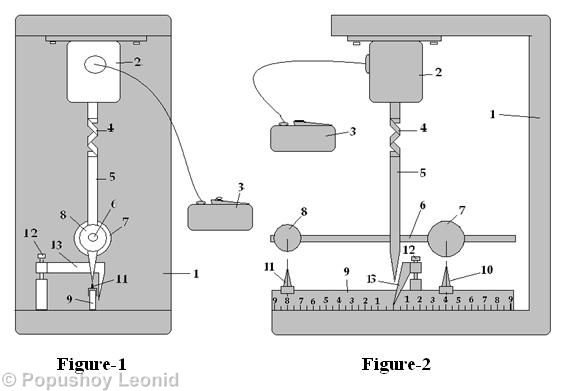
By means of the device (figure-1 and figure-2) we make the experiment.
We remove from peg 6 the balls 7 and 8, hereon by means of the remote control 3 we start the engine 2 for the system to begin revolving. The engine 2 through spring 4 rotates the axis 5 with the peg 6. We move the indicator 13 to the centre of ruler 9 from point 0. When the engine 2 rotates the axis 5 with the peg 6, there mustn’t be vibration and the indicator should stay still. Hereon we install the balls 7 and 8 on the peg 6 and by means of remote control we start the engine 2 to rotate the whole system. If happens vibration of axis 5, and the indicator 13 moves away from the point 0, then it is necessary to stop the engine 2. We move one of the balls, 7 or 8, and repeat again the experiment, by means of the remote control 3 we start the engine 2. As soon as we manage to avoid the vibration from the system during the rotation, we stop the engine 2. By means of indicators 10 and 11 we measure the distance from the balls 7 and 8 to the centre of the ruler 9. We take out of the peg 6 balls 7 and 8 and weight each of it separately.
We found the distance from the centre of ruler to each ball, and also their masses separately.
The result is:
During rotation the ball 7 with mass of 2 kg have been fixed on the peg 6 in a distance of 4 cm from the centre of ruler 9.
During rotation the ball 8 with mass of 1 kg have been fixed on the peg 6 in a distance from the centre of ruler 9.
The figure-3 demonstrates the orbits of balls 7 and 8.
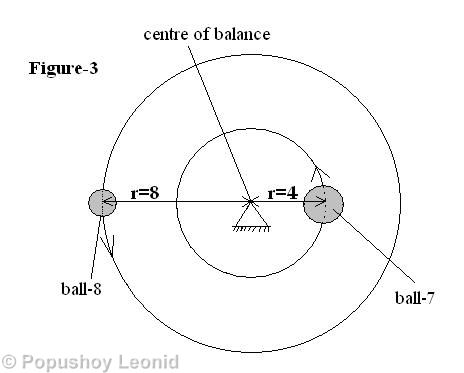
In the picture "figure-3” it is demonstrated the centre of balance, as well as that during rotation the momentums of both of the balls is equal (m1v1=m2v2). The greater ball revolves over a small circle, and the small one over a big circle. In the middle is situated the centre of balance of both of the balls. The centre of balance is calculated by weighting. During the rotation of balls, the point of balance and the equal momentums of balls constantly remain the same.
On the basis of made experiment it is clearing up the following regularity: the point, around which revolve both of the balls, is itself the centre of balance.
By means of the given experiment it is possible to explain how the orbits of Earth and Moon look.
When making the experiment, we are guided by that that the Moon and the Earth move in accordance with what is represented in the scheme "Figure-3”. The ball 8 with a smaller mass corresponds to Moon, and the ball 7 with a greater mass corresponds to Earth. The Moon has a mass, we mark it by m1, and also the Moon has a velocity, mark it with v1. The Earth has a mass, we mark it by m2, and also the Earth has a velocity, mark it with v2. The Moon and the Earth must have equal momentums, as well as the balls 7 and 8 in the figure-3. The motion of balls 7 and 8 in the experiment must correspond to the motion of Moon and Earth. Following to the Law of conservation of momentum, the Earth and Moon during their rotation must have equal momentums m1v1=m2v2.
m1v1- the mass of Moon, multiplied by its velocity;
m2v2- the mass of Earth, multiplied by its velocity.
The figure-4 demonstrates the small orbit of Earth and orbit of Moon.
How have we calculated the small orbit of Earth?
The Moon during its rotation around Earth forms a system, which is analogical with the one that is represented in figure-3. As you noticed, in figure-3 the mass of first ball is twice greater than the mass of the second ball, the orbit of first one is smaller twice than the orbit of the second one. The mass of Earth is 81 times greater than mass of Moon. The orbit of Moon must also differ by 81 times from the small orbit of Earth. We know the medium distance from Moon to Earth, which is 384000 km. This distance is itself the radius of Moon’s orbit. We divide the radius 384000 km in 81- the difference of masses and we get the radius of the small orbit of Earth, which is equal to 4740 km.
On the basis of experiment it is explained that the Earth has also a small orbit with a diameter approximately equal to 9400 km (see figure-4).

The Earth passes the way along this orbit during a month and this repeats 12 times per year. The Earth and Moon revolve around an imaginary point, which is not the centre of Earth.
The Moon and Earth form a system, and this system has a centre of balance. The centre of balance is situated between Moon and Earth at a distance of 4700 km from the centre of Earth. In the picture figure-5 it is demonstrated the centre of balance of Earth and Moon.
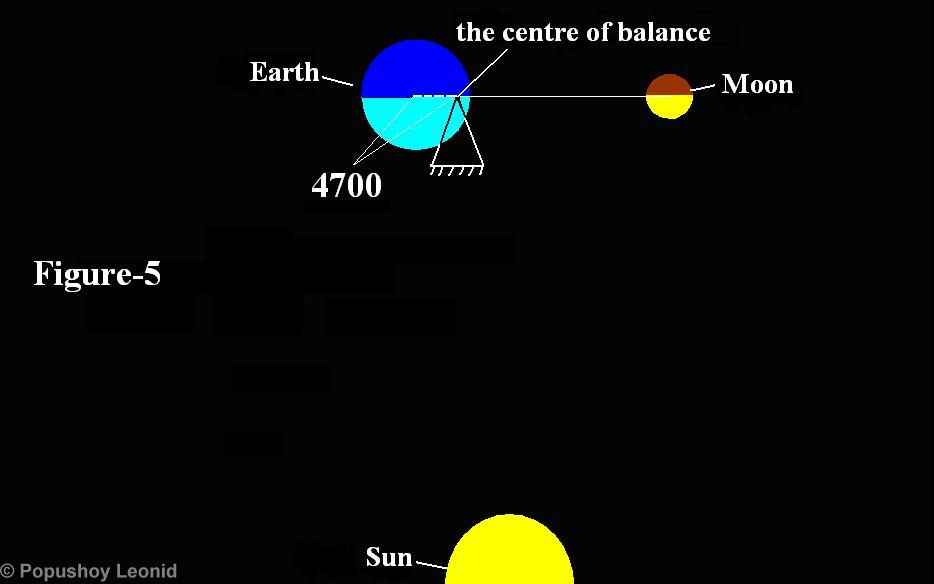
Taking in account the factor of Earth’s rotation around the Sun, we can make a conclusion that the small orbit of Earth influences on the forming of the wave-like ellipse. By means of figure-6 it is demonstrated the Earth’s orbit of a form of wave-like ellipse.
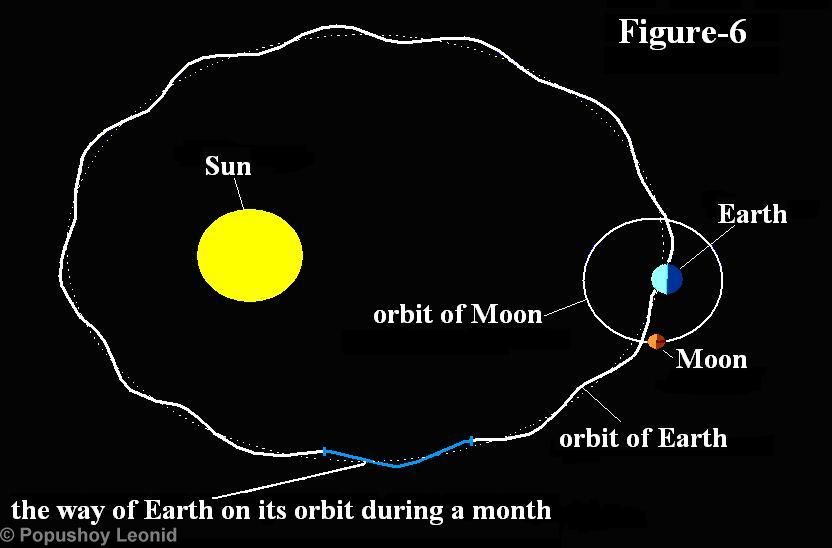
By a dotted line it is marked the orbit of Earth in accordance with the laws of modern astronomy. During a half of month the Earth passes away from its trajectory and approaches to Sun in 4740 km, and the next half of month it also passes away from its trajectory for 4740 km, but in an opposite direction.
The centre of balance, around which revolve the Moon and the Earth, is moving along the solar orbit with a constant velocity. The velocity of Earth’s motion along its orbit changes in dependence on the Moon phases. For instance: when we watch the night sky and see the new moon, we don’t even think that Earth has one velocity, but when we see the waning moon phase, then the Earth has already other velocity. The way, which Earth passes during the increasing moon phase, differs from the way, which is passed by Earth during the waning moon phase, as follows: exactly in 15 days the Earth crosses a way along its orbit more by 9400 km than in the next 15 days. By means of figure-7 it is demonstrated the difference of motion’s velocity of Earth along its orbit.
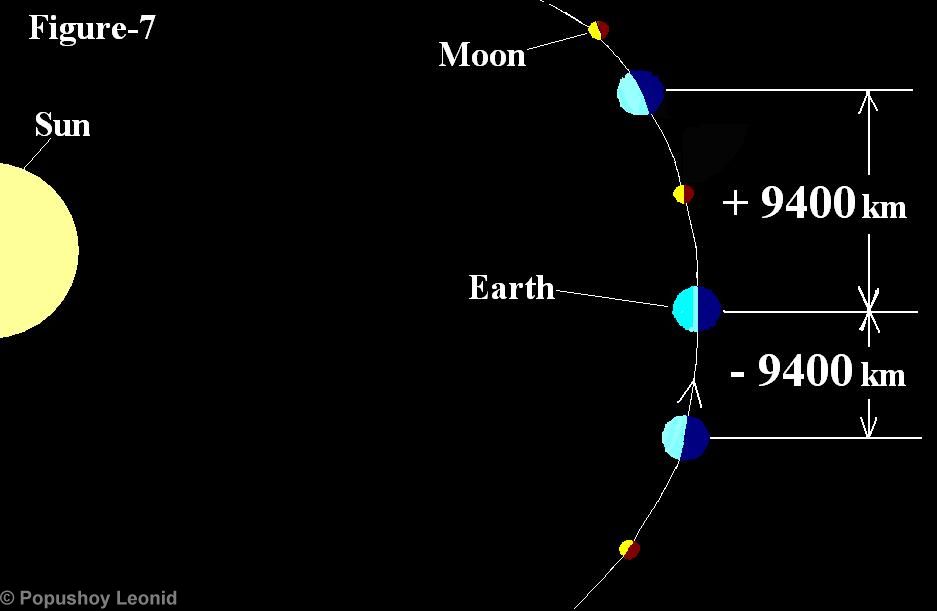
On the basis of the affirmation about that the Earth and Moon have equal momentums m1v1=m2v2 and revolve around the same centre, it is necessary to apply this calculations for all the planets, including the Sun. It is known that the planets revolve around the Sun. The planets and the Sun form equal momentums and revolve around the same point, which is situated in the centre of system, and defined by the given formula m1v1=m2v2.
m1v1- the mass of Moon, multiplied by its velocity;
m2v2- the mass of Earth, multiplied by its velocity.
This point permanently changes depending on the site of the planets to Sun. Everything aforesaid about Earth and Moon is also lawfully for the other planets from the solar system.
The planets revolve not around the centre of Sun, but around the centre of balance. For a better clarity we cite an instance with two cosmic objects: the Sun and the Jupiter. Having compared their masses we find the centre of balance (see figure-8).
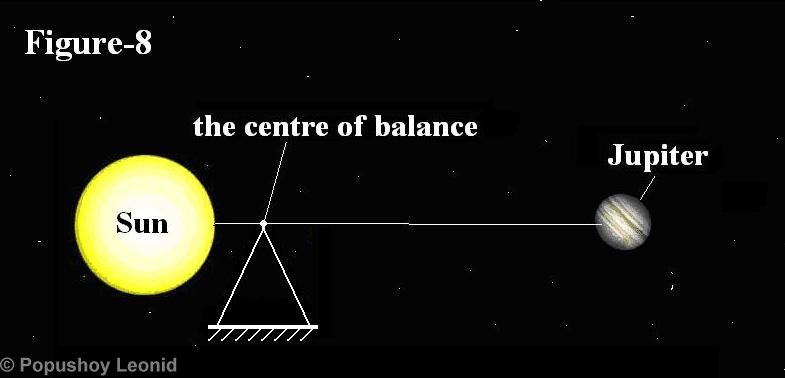
This centre is itself the point, around which revolve these two masses (see figure-9).
The figure-9 demonstrates that Jupiter revolves not around the Sun, but around the centre of balance.
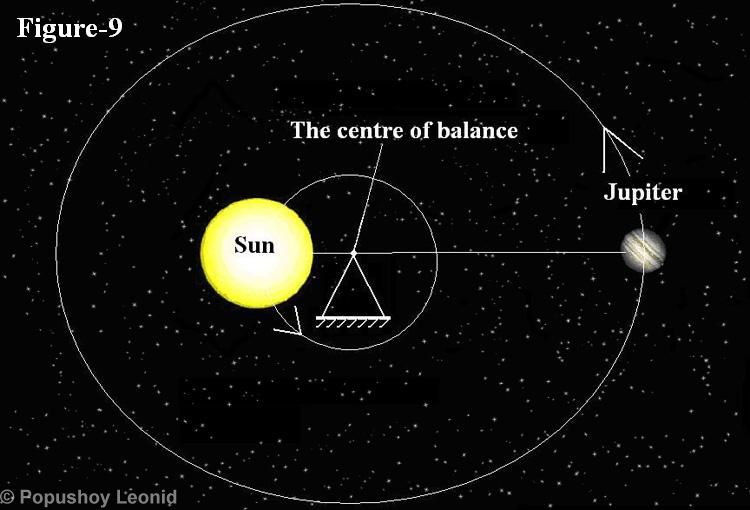
The centre of balance between the Sun and the planets is changing permanently depending on the site of planets to Sun, see figure-10. Figure-10 demonstrates all the planets, including the Sun. The planets are arranged in a row for clarity.

In cosmos every system, whether the Solar or the Galaxy, form a centre of balance, around which it revolves.
The said regularity could be used for explanation of some physical phenomena, as follows: which is the origin of whirlpools, and which is the resemblance between this phenomenon and the phenomenon of black holes from Galaxy.
Probably, everyone observed such a natural phenomena as the whirlpool. For clarity we make an experiment. We pull of the stopper from a bath of water, herewith the water rushes to the hole and soon it is beginning the forming of whirlpool. For the explanation of the essence of this natural phenomena are offered simple examples.
Imagine a game from childhood when three kids holding hands swirl, herewith one is in the middle and holds others, who spin around him (see figure-11).

At first though, seems that the one who is in middle is holding those who whirl around him, but this isn’t right. The one who is in middle is being situated in the centre of balance, and doesn’t have himself a kinetic energy equal to the energy of those who spin around, he is just maintaining the connection between them. The one from the centre could be replaced by a rope, and the result would have been the same. In this experiment it is important to pay attention to what would happen with the child from the middle if the connection will break. While whirling, the child from the centre releases a hand, as a consequence one child dashes away in a direction, and the other two in the other direction (see figure-12).
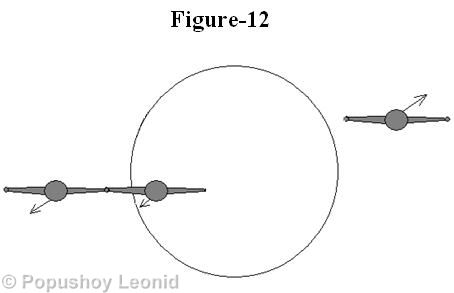
This experiment proves that the child from the middle dashed away together with the one whom he was holding, because the first one got energy from the last, that is to say he got motion. As a result we can make a conclusion: the object, which is situated in the centre having connection with others moving objects, gets from them a certain momentum and tries to leave the centre.
From analogy we return to our theme.
The water’s mass moves and rushes into the funnel. The centre to which water rushes is in the centre of the whirlpool. But because the molecules, which got the kinetic energy can’t be in the centre (the reason of this is explained in the instance with the children), in the centre of the whirlpool it is forming vacuity. We observe how around an empty centre water begin to swirl, the circles become larger and larger, the stream becomes faster, and the centre becomes clearer. This happens when the centrifugal power prevail over the centripetal power.
The origin of tornado is similar to the origin of the whirlpool forming. In the centre of tornado it is forming a very low pressure, as a result in the centre is forming vacuum, which has the sucking power.
The experiment proves that in the centre of Galaxy should be forming a vacuity. Between the stars exists an attraction power and those, which are in the centre, get the kinetic energy from the ones that revolve around them. The star, which has a kinetic energy, couldn’t stay in the centre of Galaxy, it tries to move away from centre. On Earth, in the centre of tornado, and in the centre of whirlpool acts the sucking power of the vacuum centre, because there exists the atmospheric pressure, but in cosmos it doesn’t happen, because there is a vacuum environment.
The conclusion of second chapter is the second regularity:
The planets move along elliptical orbits with the centre of balance between Sun and planets in one of the foci.
